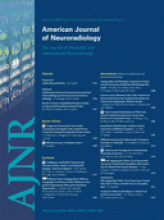Abstract
BACKGROUND AND PURPOSE: Hippocampal malrotation (HIMAL) is a failure of hippocampal inversion that occurs during normal fetal development and has been seen on MR imaging examinations of people with epilepsy, but it has not been studied in patients without epilepsy. We intended to evaluate the prevalence of HIMAL in MR imaging examinations of patients without seizures to better understand the significance of HIMAL in the population with seizure.
MATERIALS AND METHODS: A total of 497 MR imaging examinations with thin-section imaging through the temporal lobes of patients referred for conditions other than seizures were reviewed. The examinations were performed on 1.5T magnets. Sagittal T1-weighted and coronal T2-weighted images were used to evaluate each MR image for the distinctive features of HIMAL. As previously described in the literature, the criteria for HIMAL include unilateral involvement and incomplete rotation of a hippocampus that is normal in size and signal intensity but abnormally rounded in shape, with blurred inner structure. In addition, ipsilateral findings of an atypical collateral sulcus angle and atypical position and size of the fornix were noted. The corpus callosum is normal, and the temporal lobe remains normal in size, though the temporal horn may appear enlarged.
RESULTS: None of the patients’ examinations fulfilled all of the HIMAL criteria. Six studies satisfied 2 or more criteria, which included an abnormally rounded hippocampus and a vertical collateral sulcus. These HIMAL findings were all seen on the left. Forniceal asymmetry was the most prevalent abnormality, with 289 patients manifesting a low position of 1 fornix.
CONCLUSIONS: Hippocampal malrotation is a rare finding in patients without seizures. HIMAL is therefore likely to be a pathologic finding.
- Copyright © American Society of Neuroradiology
Indicates open access to non-subscribers at www.ajnr.org











